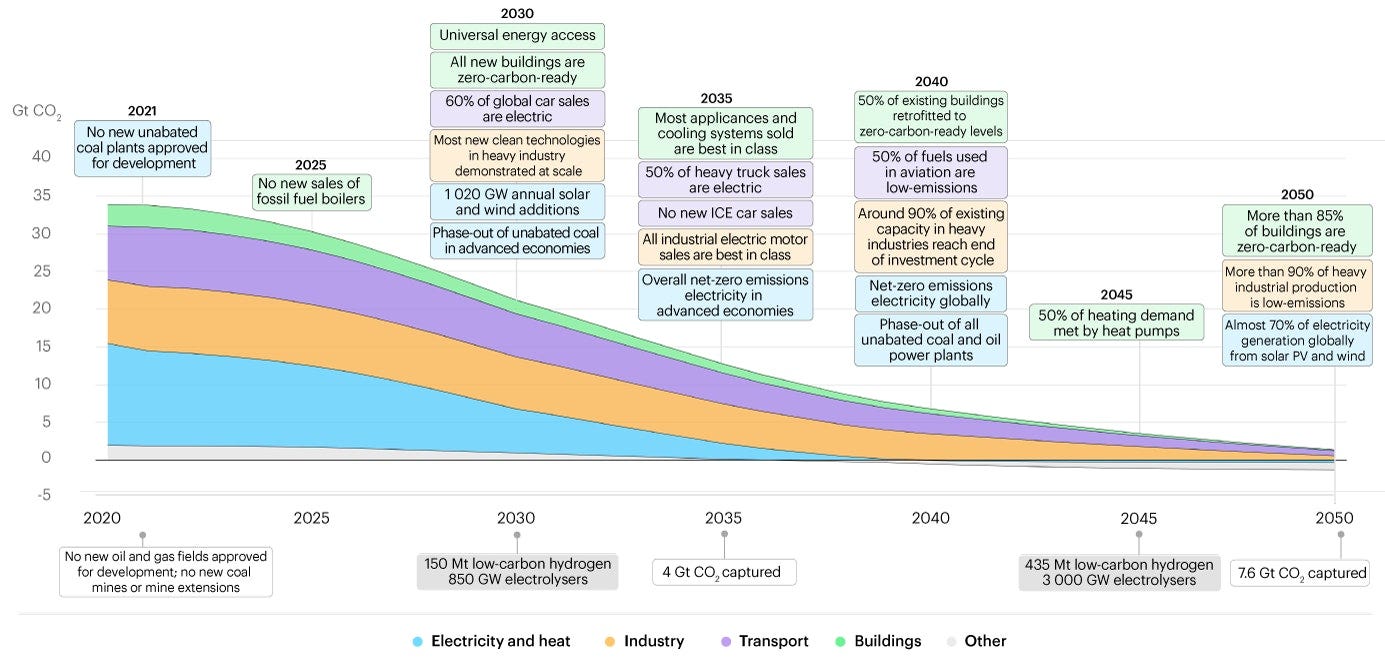Net-Zero by 2050 Means Huge Action by 2030
The first comprehensive plan detailing how to achieve net-zero by 2050 from the IEA; plus, a Biden speech on EVs
Breaking:

President Biden has delivered remarks concerning electric vehicles and the American Jobs Plan at a Ford electric vehicle (EV) plant in Dearborn, Michigan. He emphasized the need for America to strengthen its ability to manufacture EV parts from semiconductors to batteries. He also continually reiterated support for unionization and good, American jobs. While a bit of a promo piece for Ford (which maybe have small merit in light of the electric F-150 and whatnot), commitments and shows of concern for climate action and solutions like EVs in line with what the below IEA report suggests1 are vital, so this speech is appropriate, especially with its emphasis on constructing huge numbers of new EV charging stations. They will be quite necessary considering that the IEA estimates that we need 60% of new car sales to be EVs by 2030.
Towards the end of the speech, President Biden spoke of the recently held Climate Summit and of his aims in it to congregate all the world’s leaders around the idea that the climate crisis is the crisis of our times. Going further, that it can be solved alongside the creation of millions of good jobs. He then concluded by revealing another aim of the summit, to tell world leaders:
America is back
At least in light of the mighty threat that is climate change and the action we need to take to stop it, it seems like we may well be.
Now back to you regularly scheduled program:
The International Energy Agency (IEA) has released their special report2 detailing the first comprehensive plan for the global transition to net-zero carbon emissions by 2050. Here are some highlights3:
No need for new fossil fuel supply investments, oil, gas, and coal, as of this year.
Beyond projects already committed as of 2021, there are no new oil and gas fields approved for development in the IEA pathway, and no new coal mines or mine extensions are required
30 million jobs will be created, 5 million jobs lost.
By 2030, total annual energy investment surges to USD 5 trillion, adding an extra 0.4 percentage point a year to annual global GDP growth, based on IEA’s joint analysis with the International Monetary Fund.
By 2030, achieve universal energy access by providing electricity to 785 million people that have no access and clean cooking solutions to 2.6 billion people.
By 2030, wind and solar energy experience a quadrupling of capacity from current values.
By 2030, EVs reach more than 60% of global car sales, as compared with their current 5% share.
By 2035, no more sales of internal combustion engine (ICE) cars4; this entails an 18x increase of EV sales from their current numbers.
By 2040, global electricity system reaches net-zero emissions.
By 2050, global energy demand is around 8% smaller than today, but serves an economy more than twice as big and a population with 2 billion more people. That means energy use becomes much more efficient along with other behavioural changes.
By 2050, two-thirds of total energy supply is from wind, solar, bioenergy, geothermal and hydro energy. Solar PV capacity increases 20-fold and wind power 11-fold.
Continuing, fossil fuels drop from four-fifths of total energy supply today to slightly over one-fifth by 2050. Fossil fuels that remain are used in goods where the carbon is embodied in the product such as plastics, in facilities fitted with carbon capture, utilization, and storage (CCUS), and in sectors where low-emissions technology options are scarce.
Other points of note:
The estimates found in IEA’s report and net-zero emissions (NZE) scenario are among the lowest in their dependencies on CO2 capture and removal technologies and developments.
“…around 55% of the cumulative emissions reductions in the pathway are linked to consumer choices such as purchasing an EV, retrofitting a house with energy-efficient technologies or installing a heat pump.”5
Making net-zero emissions a reality hinges on a singular, unwavering focus from all governments – working together with one another, and with businesses, investors and citizens.
This is not simply a matter of all governments seeking to bring their national emissions to net zero – it means tackling global challenges through coordinated actions.
All in all, the plan is ambitious, but achievable with an immense amount of political motivation and activist pressure. We have a decent number of world leaders ostensibly game to fight back against climate change, but the political will needed to fight back against historically entrenched interests is and will continue to be mighty. Though, now we have a plan to aid in our efforts, so any excuses centered on a lack of roadmap are moot. We know how to achieve a strong mitigation of and adaptation to climate change, now we must actually do it, with more clean energy, more electric cars, more energy efficiency, more responsible investment, and a whole lot less of the blind expansionism that got us into this mess.
With plan in hand, ever onwards!
And feel free to give the livestream press release a watch too:
demands
The page has lots of cool infographics, highly recommend checking it out.
Note the abundance of goals which need to be met by 2030.
ICE trucks are still sold, but in lower numbers.
These consumer choices must be facilitated by policy action that allows said choices to be viable and accessible.




